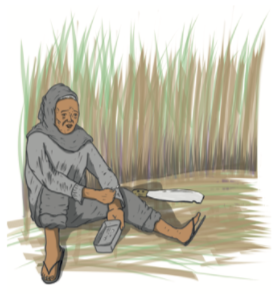
At four o’clock in the morning, Tatay Romeo, 66 years old from Cadiz City, woke up to prepare for the entire day of cutting and loading sugarcane. Nanay Celia, 52 years old, also woke up at the same time to prepare for assigning work and work areas (pang-arima) to farm workers. They drink coffee, eat a bit and make sure to pack food for an entire day’s work, rain or shine. Each of them must be at work at six o’clock in the morning.
Negros Island is known for its quality and sweet sugar from sugarcane produced in 62% of the island’s land area that contributes to almost 70% of total sugar production in the Philippines.
For Tay Romeo’s extremely dangerous around-the-clock work of cutting and loading sugarcane, the landlord merely payed the labor of his group on piece-rate (pakyaw) of ₱190 per ton. It is better during milling season because he can get as much as ₱2,000 per week, but he only earns half of this amount when its off-milling season from working on piece-rate, including weeding.
“Our wages are really not enough to make ends meet considering our weekly needs, we can only afford our expenses once we get our pension,” Tatay Romeo said while calculating his household expenses. Each week, he allots ₱500 for rice, ₱350 for fish and dried fish, ₱200 for other needs, ₱1,000 for the allowance of his two college students who are sponsored by his relatives, and saves ₱500 for the monthly electricity bill.
In paper, Tay Romeo is already retired from working in sugarcane fields since he was 15 years old. He is seemingly lucky because he is one those who have SSS benefits and now receives a monthly SSS pension of ₱3,000, but with no land to till, he is forced to continue cutting and loading sugarcane to provide for his family.
In another part of Negros Island, in the town of Toboso, Nanay Celia endures a ₱150 daily wage for three hours of work in sugarcane fields. For working six days per week, she earns barely ₱1,000.
“If Tim Ballesteros had not increase wages by ₱15 daily after the NPAs burned his trucks (in January 2023), our wages would not have been raised,” shared Nay Celia. Tim Ballesteros is the leading comprador-landlord in northern parts of Negros and the one who dictates wages and the management of work in sugarcane fields.
Tay Romeo and Nay Celia are among the estimated 380,000 farm workers in sugarcane fields on Negros Island. There are another 18,000 workers all over the island scattered in 12 sugar mills (of the 27 in the entire Philippines).
Berting, 39 years old from Toboso, is one of the sugar mill workers. He is a ‘hooker’ in a transloading station where he unloads sugarcanes from the truck and loads these to a hauler to transport the sugarcane to the mills. He works in a transloading station owned by Victorias Milling Corporation (VMC), the biggest sugar mill in the entire Asia, but he still works on piece-rate of ₱5 per ton. For 20 years of work as a ‘hooker,’ his wage increased only once in 2012; already over a decade since wages for unloading-loading sugarcane were raised by ₱1 per ton.
“We are casual workers until now as there are no regular ‘hookers’ that I know of here in Toboso. It is either too hot or we are drenched in the rain because transloading stations should be cleared,” Berting said. Because Berting is not a regular worker, he does not receive any benefits like SSS or 13th month pay. He brings ₱5,000 every 15 days to his family.
The work of ‘hookers’ like Berting is very dangerous. The heat is scorching during summer, while narrow ladders they use to board the trucks and the sugarcane are very slippery during the rainy season. The company does not provide them uniforms or any form of protective gear.
With the successive increase of price of goods, farm and mill workers have not received any substantial increase to their wages. “People need to unite to solve the problem and crisis, like expensive goods and the need to increase wages,” Nay Celia said. When asked what workers currently need, Berting answered, “wage increase, with SSS included.” Livelihood is Tay Romeo’s demand, “land to till and just wages and benefits so we can live properly without hunger.”
Tay Romeo also pointed out that the piece-rate (pakyaw) system is the reason why their wages are low. “The management of haciendas is unjust, especially those work entrusted to contractors, usually we are only given piece-rate jobs. We only earn very little each week,” Tay Romeo concluded.
Tatay Romeo, Nanay Celia, and Berting are some of those who work hard and sell their labor power to produce sugar that sweetens people’s food and drinks, yet their lives that are tied to sugarcane plantations are very bitter.
